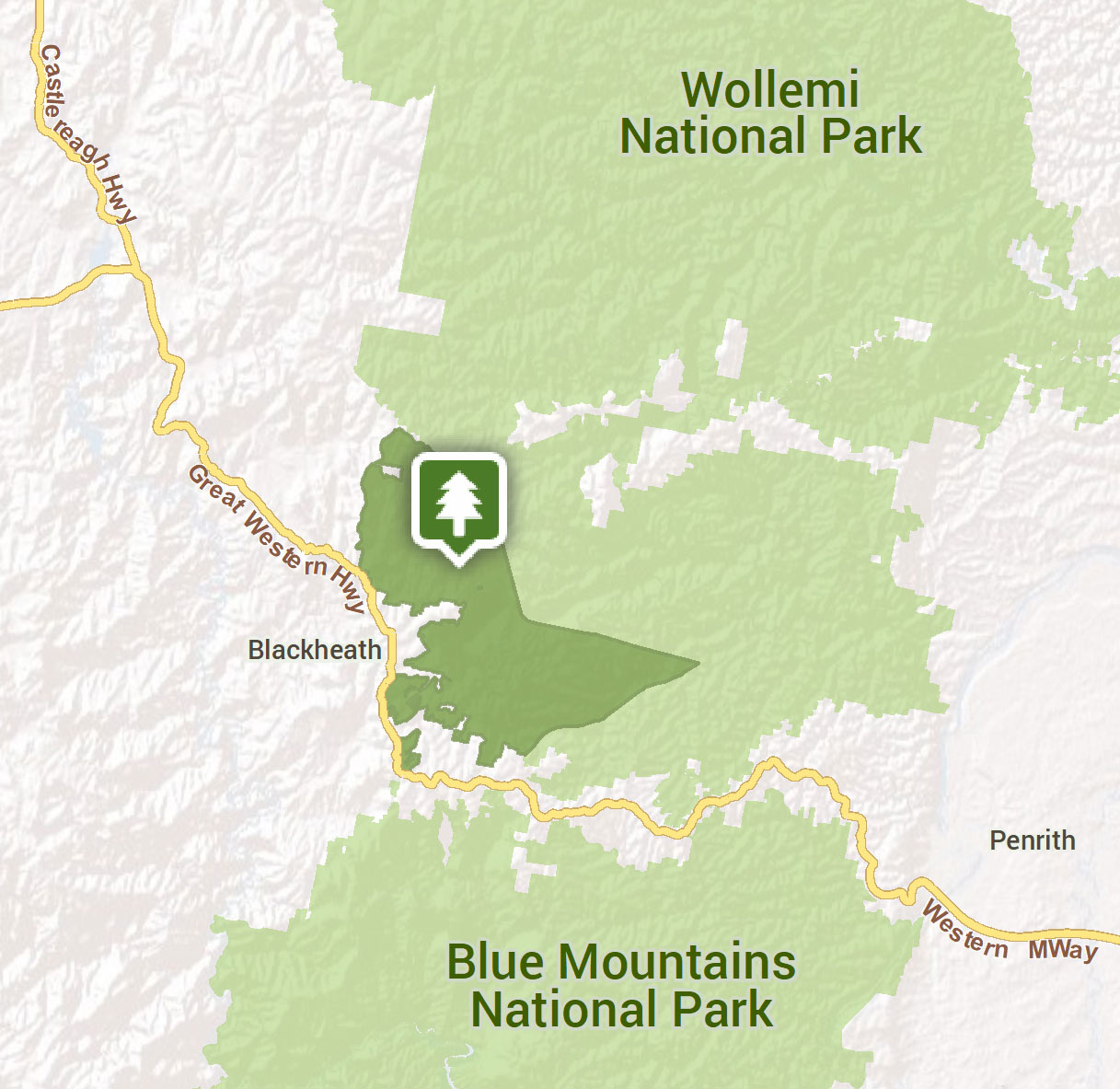Blackheath area
Blue Mountains National Park
Visitor info
All the practical information you need to know about the Blackheath area.
Getting there and parking
To get to the Blackheath area of Blue Mountains National Park:
From Sydney:
- Head west on the Western Motorway (M4) and Great Western Highway.
- Blackheath is around 12.5km beyond Katoomba. Turn right onto Govetts Leap Road and follow to the end to reach Blue Mountains Heritage Centre.
- You can also take Bells Line of Road from Richmond, then turn south on the Darling Causeway which connects with the Great Western Highway at Mount Victoria.
From Lithgow:
- Head east on the Great Western Highway.
- Blackheath is around 28km from Lithgow.
- Mount Victoria is around 9km from Lithgow.
Parking Show more
- Blue Mountains Heritage Centre See on map
- Butterbox Canyon See on map
- Evans lookout See on map
- Fortress Canyon See on map
- Govetts Leap lookout See on map
- Jugglers Canyon See on map
- Perrys lookdown See on map
- Pulpit Rock lookout See on map
- Victoria Falls walking track See on map
By bike
Visit Transport for NSW for cycling and bike transport information.
By public transport
- Regular trains run from Sydney Central Station to Blackheath and Mount Victoria. The trip takes about 2 hours. Visit Transport for NSW to plan your trip.
- Daily buses run between Katoomba and Blackheath, including wheelchair-accessible services. Buses run Monday to Friday from Katoomba to Mount Victoria. Visit the Blue Mountains transit website for information.
Best times to visit
Blackheath area spoils you with its diverse attractions all year. Here are some highlights.
Autumn
Autumn brings crisp mountain air and clear blue skies tempting you to get back to nature. Set out on a gentle stroll, heart-pumping hike, exhilarating mountain bike ride or trail run. The steep descents and challenging climbs to Grand Canyon or Blue Gum Forest will soon warm you up. Camp under the stars and fall asleep to the whispers of the wilderness. You’ll find it hard to believe Sydney is only 2hrs away.
Spring
Spring is prime time for wildflowers and birdwatching. Spot pink boronias, heath banksia and yellow conesticks that look like ice cream cones. In November the iconic waratah flowers along Fairfax Heritage track, while grass trees flower on the escarpment. Look out for king parrots and nectar-loving honeyeaters in the trees. This is also a great time to explore on 2 wheels. Ride along Mount Hay Road surrounded by flowering heathland. If you’re lucky you might even see a giant dragonfly as they emerge in late October.
Summer
Rediscover the great outdoors on a bushwalk or try something new like an introductory canyoning tour. After a summer rain shower the waterfalls are in full flow. Mossy hanging swamps drip crystal clear water, cooling you off along Govetts Leap descent. The fine weather is perfect for evening picnics and stunning sunsets from the lookouts. Need to keep the kids entertained? Check out the heritage centre’s tours and activities during school holidays.
Winter
You may catch a dusting of snow in the upper mountains at Blackheath and Mount Victoria. Winter-blooming sunshine wattle brings splashes of yellow alongside walking tracks. If you prefer to explore from the warmth of your car, Blackheath lookouts drive is an easy way to see the area’s world-class views. Detour to Wind Eroded Cave and Anvil Rock on your way to Perrys Lookdown, and don’t miss Pulpit Rock. Council-owned Hargreaves and Mount Blackheath lookouts offer sweeping views over the Megalong and Kanimbla Valleys.
Facilities
Toilets Show more
- Acacia Flat campground
- Blue Mountains Heritage Centre
- Evans lookout
- Fairfax Heritage walking track
- Govetts Leap descent
- Govetts Leap lookout
- Jugglers Canyon
Picnic tables
Cafe/kiosk
Drinking water
Wireless internet
Electric power
Maps and downloads
Permitted
Walking and cycling groups in the Grose Wilderness are limited to 8 people.
Camp fires and solid fuel burners
Campfires are permitted only in the fire pits provided. Bring your own firewood. Campfires and solid fuel burners may be prohibited during high fire season.
Camping
In designated campgrounds only.
Prohibited
Pets
Pets and domestic animals (other than certified assistance animals) are not permitted. Find out which regional parks allow dog walking and see the pets in parks policy for more information.
Smoking
NSW national parks are no smoking areas.

Contact
- in Blue Mountains National Park in the Sydney and surrounds region
Blackheath area is always open but may have to close at times due to poor weather or fire danger.
-
-
Blue Mountains Heritage Centre and Blackheath office
02 4787 8877
Contact hours: 9am to 4.30pm daily. Closed Christmas Day. - 270 Govetts Leap Road, Blackheath NSW 2785
-
Email: bluemountains.heritagecentre@environment.nsw.gov.au
-
Blue Mountains Heritage Centre and Blackheath office
Visitor centre
-
Blue Mountains Heritage Centre
270 Govetts Leap Road, Blackheath NSW 2785 - 9am to 4.30pm daily. Closed Christmas Day.
- 02 4787 8877
Nearby towns
Lithgow (28 km)
Hassans Walls Lookout, near Lithgow, is the highest in the Blue Mountains. Admire Mt Wilson, Mt York, Mt Tarana and Mt Blaxland as well as the pretty Hartley Valley below. To the south are the Kanimbla and Megalong valley and Mt Bindo. While there, go for a walk or ride around the lookout.
Blackheath (2.5 km)
The magnificent Govetts Leap waterfall drops a whopping 180m to the base of the cliff. The 'ozone-laden' air of the Blue Mountains was promoted as a health tonic since the early 1800s, and when you get there, you'll realise why.
Katoomba (12.5 km)
Katoomba is at the heart of most of the stunning natural attractions that make up the Blue Mountains National Park. You can admire deep valleys, sandstone plateaus, waterfalls and native animals from the many walking trails and lookouts near Katoomba.